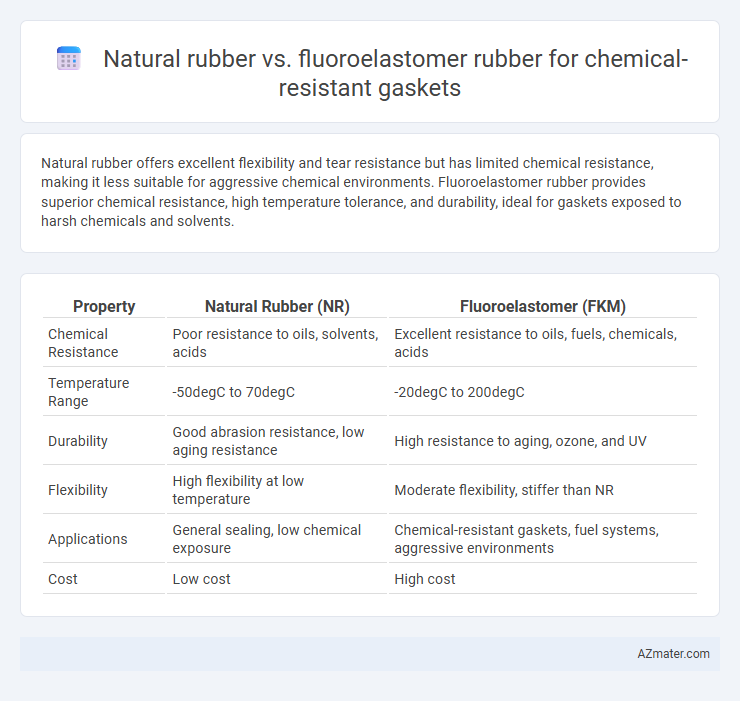Natural rubber offers excellent flexibility and tear resistance but has limited chemical resistance, making it less suitable for aggressive chemical environments. Fluoroelastomer rubber provides superior chemical resistance, high temperature tolerance, and durability, ideal for gaskets exposed to harsh chemicals and solvents.
Table of Comparison
| Property | Natural Rubber (NR) | Fluoroelastomer (FKM) |
|---|---|---|
| Chemical Resistance | Poor resistance to oils, solvents, acids | Excellent resistance to oils, fuels, chemicals, acids |
| Temperature Range | -50degC to 70degC | -20degC to 200degC |
| Durability | Good abrasion resistance, low aging resistance | High resistance to aging, ozone, and UV |
| Flexibility | High flexibility at low temperature | Moderate flexibility, stiffer than NR |
| Applications | General sealing, low chemical exposure | Chemical-resistant gaskets, fuel systems, aggressive environments |
| Cost | Low cost | High cost |
Introduction: Importance of Chemical-Resistant Gaskets
Chemical-resistant gaskets are critical in ensuring the integrity and safety of equipment handling aggressive chemicals in industries such as oil and gas, pharmaceuticals, and manufacturing. Natural rubber offers flexibility and cost-effectiveness but lacks resistance to harsh chemicals, making it less suitable for aggressive environments. Fluoroelastomer rubber, with superior chemical resistance and temperature tolerance, is preferred for high-performance gasket applications where durability and reliability are essential.
Overview of Natural Rubber and Fluoroelastomer Rubber
Natural rubber exhibits excellent elasticity and resilience but has limited chemical resistance, making it less suitable for aggressive chemicals. Fluoroelastomer rubber offers superior resistance to a wide range of chemicals, high temperatures, and oils, making it ideal for demanding gasket applications. The choice between natural rubber and fluoroelastomer depends on the specific chemical exposure and operating environment of the gasket.
Chemical Resistance Properties Comparison
Fluoroelastomer rubber exhibits superior chemical resistance compared to natural rubber, effectively withstanding exposure to oils, fuels, acids, and solvents, making it ideal for harsh chemical environments. Natural rubber demonstrates limited resistance and tends to degrade when in contact with hydrocarbons, solvents, and aggressive chemicals, restricting its application in chemical-resistant gaskets. Fluoroelastomer's molecular structure enhances durability and longevity in corrosive conditions, providing a more reliable sealing solution for chemical processing industries.
Temperature Range and Thermal Stability
Natural rubber offers a temperature range of approximately -50degC to 70degC, with moderate thermal stability suitable for low to medium heat applications. Fluoroelastomer rubber excels with a wider temperature tolerance ranging from -26degC up to 204degC, providing superior thermal stability and resistance to degradation under high-temperature and chemically aggressive environments. This makes fluoroelastomer the preferred choice for chemical-resistant gaskets in demanding industrial settings where consistent performance at elevated temperatures is critical.
Mechanical Strength and Durability
Fluoroelastomer rubber exhibits superior mechanical strength and durability compared to natural rubber when used in chemical-resistant gaskets, maintaining integrity under high temperatures and aggressive chemical exposure. Natural rubber tends to degrade faster in harsh chemical environments, leading to reduced lifespan and frequent gasket replacement. Fluoroelastomer's enhanced resistance to compression set and oxidative aging ensures longer service life and reliable sealing performance in industrial applications.
Compatibility with Various Chemicals
Natural rubber offers excellent abrasion resistance but exhibits poor compatibility with oils, fuels, and many chemical solvents, limiting its effectiveness in aggressive chemical environments. Fluoroelastomer rubber, known for superior chemical resistance, performs well against hydrocarbons, acids, and alkalies, maintaining integrity in high-temperature and harsh chemical applications. This makes fluoroelastomer the preferred choice for chemical-resistant gaskets requiring durability and compatibility with a wide range of chemicals.
Environmental and Safety Considerations
Natural rubber offers excellent biodegradability and lower environmental impact due to its renewable plant-based origin, making it a safer choice for applications with minimal chemical exposure. Fluoroelastomer rubber provides superior resistance to aggressive chemicals and high temperatures but poses environmental concerns due to its synthetic, non-biodegradable composition and potential for toxic byproducts during disposal or incineration. Choosing between them involves balancing natural rubber's eco-friendly properties against fluoroelastomer's enhanced chemical durability and associated environmental and safety trade-offs.
Cost Analysis and Economic Factors
Natural rubber offers lower initial cost and ease of processing, making it economically attractive for general-purpose chemical-resistant gaskets with moderate exposure conditions. Fluoroelastomer rubber, while significantly more expensive in raw material and manufacturing costs, provides superior chemical resistance, durability, and longer service life, leading to reduced replacement frequency and lower total cost of ownership in harsh chemical environments. Economic factors favor natural rubber in low-budget applications with limited chemical exposure, whereas fluoroelastomers justify their higher price through lifecycle savings in aggressive chemical settings.
Typical Applications in Industry
Natural rubber gaskets excel in applications requiring high elasticity and moderate chemical resistance, commonly used in automotive sealing, water treatment, and general industrial machinery where exposure to oils, mild acids, and alkalis occurs. Fluoroelastomer rubber gaskets offer superior chemical resistance to fuels, oils, and aggressive chemicals, making them ideal for aerospace, oil and gas, and chemical processing industries where durability under harsh chemical exposure and high temperatures is critical. The choice between natural rubber and fluoroelastomer is driven by the specific chemical environment, temperature range, and mechanical stress conditions typical of the intended industrial application.
Conclusion: Selecting the Right Gasket Material
Fluoroelastomer rubber offers superior chemical resistance, high temperature tolerance, and excellent durability, making it ideal for gaskets in aggressive chemical environments. Natural rubber provides good flexibility and compression set properties but lacks resistance to oils, fuels, and many solvents, limiting its use in harsh chemical conditions. Selecting the right gasket material depends on the specific chemical exposure, temperature requirements, and mechanical stresses, with fluoroelastomer preferred for demanding applications and natural rubber suited for less aggressive environments.

Infographic: Natural rubber vs Fluoroelastomer rubber for Chemical-resistant gasket
 azmater.com
azmater.com